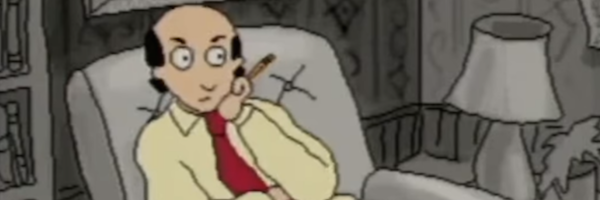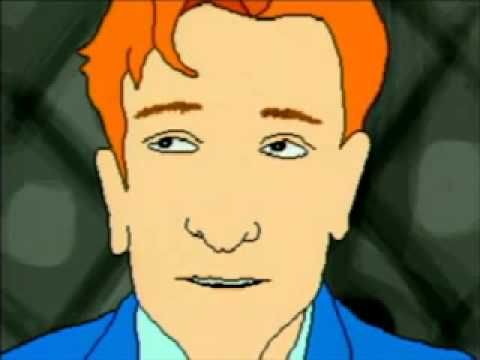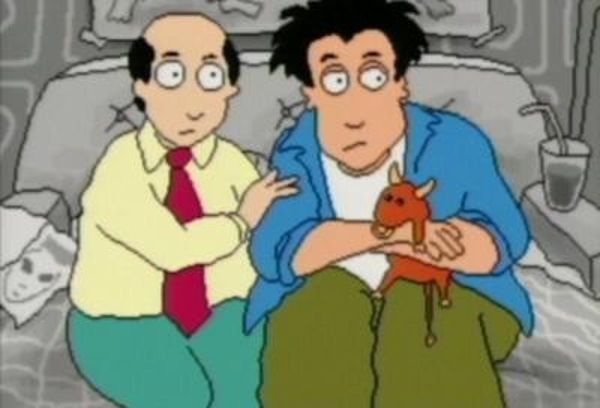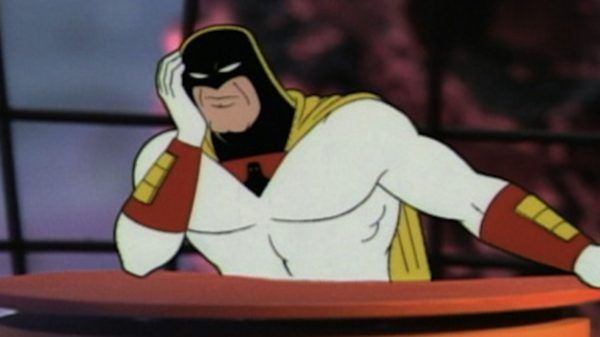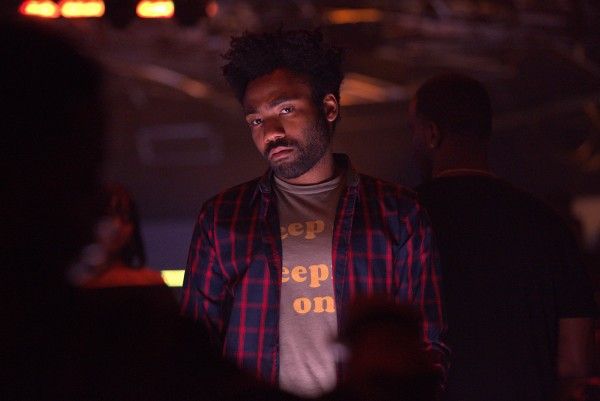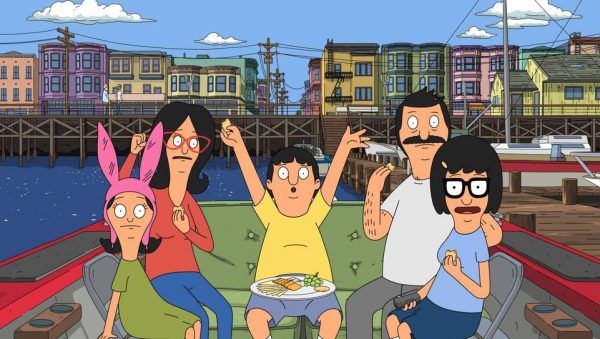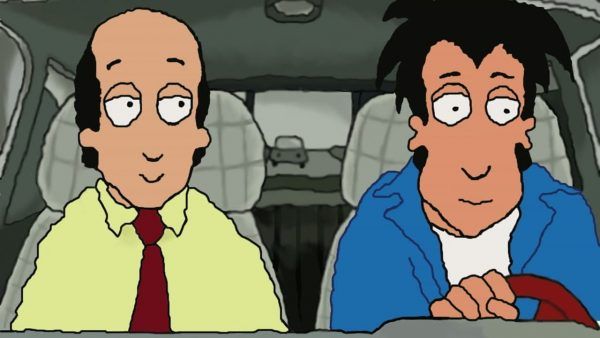I was a strange child. I didn't have cable TV growing up, so whenever I was at a friend's or relative's house who did, I would, like many kids of my generation, glue myself to that set and absorb what I'd been missing. But unlike other kids, whom I imagine were interested in MTV, Cartoon Network, and scrambled dirty channels, I couldn't get enough of the low-key misadventures of a middle-aged therapist talking to his comedian clients.
Dr. Katz, Professional Therapist originally aired on Comedy Central from 1995-2002. Created by Tom Snyder and Jonathan Katz, with producer Loren Bouchard offering a strong creative voice as well, the animated comedy saw Katz playing a fictionalized version of himself as, well, a professional therapist. Each episode featured Katz having therapy sessions with standup comedians delivering conversationalized versions of their material, with Katz interjecting thoughts and observations as if they were actual therapy issues (and when it comes to standup comedy, they usually are). Episodes also highlighted Katz's personal life, especially his relationships with his manchild son Ben (H. Jon Benjamin) and his irascible secretary Laura (Laura Silverman), and his small, relatable goals. The entire show was improvised based on loose beat sheets, rather than the tight scripts you'd usually see in animation, resulting in scenes that felt authentic and organic.
Notable guests on Dr. Katz's couch included Ray Romano, Janeane Garofalo, Marc Maron, Garry Shandling, Bob Odenkirk, Jon Stewart, Rodney Dangerfield, Joan Rivers, Bobcat Goldthwait, David Cross, David Mamet, Lisa Kudrow, Julia Louis-Dreyfus, Jim Gaffigan, Dave Chappelle, Conan O'Brien, Gilbert Gottfried, Kevin Nealon, Denis Leary, David Duchovny, Patton Oswalt, Ben Stiller, Tom Kenny, Harry Shearer, Sarah Silverman, Jeff Goldblum, Paul F. Tompkins, Margaret Cho, Mitch Hedberg, Wanda Sykes, Catherine O'Hara, Whoopi Goldberg, and Winona Ryder.
The show was well-regarded among comedy fans and critical circles alike, earning an Emmy and a Peabody award during its run. It also earned Katz quite a bit of success; as he tells the AV Club, "the popularity of Dr. Katz won me the audience I'd been coveting all those years." But the real measure of Dr. Katz, Professional Therapist's legacy comes from the unmistakable DNA transfusion you can see in tons of contemporary television thereafter -- and not just in the world of animation. Pull up a couch: Here are the many ways Dr. Katz influenced TV today.
The Power of Squigglevision
When you watch an episode of Dr. Katz, you may think your eyes are tricking you. I beseech thee: Give in. The show was produced with an animation technique called Squigglevision, which according to Katz, came from co-creator Snyder. "He, at the time, had been building a company called Tom Snyder Productions, which is a really extraordinary educational-software company. He had just created this new kind of technology called Squigglevision, cause he's wicked smaht, as they say in Boston." As you may guess, the resulting visual effect of Squigglevision are squiggles. Even -- especially! -- when a character is just sitting in a chair, as they do often in Dr. Katz, their body is constantly squiggling around, their outlines moving subtly within the same few frames and back again, causing a constant implication of motion.
This method of animation, used explicitly in future shows like Science Court and Home Movies (both of which shared much of the same creative crew as Dr. Katz), does a few things that ripple throughout television animation thereafter. From an aesthetic standpoint, it shows you don't need the stereotypically bright, multi-colored, professionally clean look of animation to hit on TV. The handmade squiggles of Dr. Katz -- coupled with the literally desaturated backgrounds, rendered in sketchbook feeling black-and-white -- proved that audiences were ready for experimentation in what their small-screen animation looked like.
And from a production standpoint, it made things way, way cheaper. "There are almost no disadvantages," said Snyder of the technique. "It costs just as much to do a helicopter scene as it does to do a living room scene." This level of cheapness resulted in less cooks in the kitchen from every level, resulting in a purity of the work. As Bouchard said, "We’ve invented a system that allows a small number of people to work at something without nitpicking it to death... It’s more like being in a rock band than working in an animation studio." And while you don't see Squigglevision on TV these days anymore, I'd argue the method led directly to the common and cheap practice of Flash animation -- Home Movies switched to this in season two, and many of your favorite animated shows use this method or versions like it.
A successful show that used cheaper production techniques, experimental animation, and smaller, punkier crews leads us directly to the success of...
Adult Swim
Space Ghost Coast to Coast debuted on Cartoon Network one year before Dr. Katz. Like Katz, it's primarily a show about sitting and talking, uses cheap animation techniques (in this case, reused cycles from the '60s Space Ghost cartoon), and mines its humor from awkward, surreal, improvised moments of conversational explorations. But it didn't originally air on what we now call Adult Swim, a late-night block/indie network dedicated to bizarre alt-comedy. It was just a strange late night Cartoon Network show not quite for the kiddies. Adult Swim didn't officially begin until 2001, years after the success of and appetite for both SGC2C and Dr. Katz were set in stone -- not to mention the proven track record of their cheap, creatively experimental production methods. These two shows are, in my eye, sister shows. One show's impact directly affected the other, and vice versa. Without Dr. Katz, I don't believe there is enough confidence in the appeal of a network full of SGC2C-styled shows. In other words, an Adult Swim.
Sealab 2021, Harvey Birdman, Attorney at Law, The Brak Show, Aqua Teen Hunger Force, Home Movies -- all of these preliminary Adult Swim shows are rife with Dr. Katz DNA. You can feel the antagonistic Laura in the antagonistic employees of Sealab, the recontextualization of someone's well-known career in Harvey Birdman, the family dynamics of Katz and Ben in The Brak Show, and the improvised-feeling non sequiturs in Aqua Teen. But more broadly, all of these shows used Dr. Katz's particular style and charms as a runway to takeoff into further "cheap, creatively adventurous, interestingly animated comedy for adults." And Katz was not left without a hat tip. In the later Adult Swim series Squidbillies, Katz voices not only a main character's therapist, but several other roles throughout the run. Dr. Katz has influenced many animated shows in its wake (they pay homage to it in an episode of Arthur, for goodness' sake), but no entity so crystal clear as Adult Swim, even in contemporary shows like 12 oz. Mouse, China, IL, and especially Joe Pera Talks with You.
Bringing it back to the sources, SGC2C has directly referenced and paid tribute to Katz in two episodes of its run. In season four's "Brilliant Number One," Space Ghost appears for a brief moment in a squiggly, hand-drawn, Katzian animation style when he asks Peter Fonda the very Katzian question, "What does this tell us about your childhood?" And in season six's "King Dead," which featured H. Jon Benjamin as a guest, Space Ghost appears in this style again when he insists how important cable television is to him.
Comedians in Dramedies Getting Serious
The show itself, regardless of what anybody says, was really about a father and a son, and a shrink and his receptionist. The comedians were really wonderful, but the show was really about Dr. Katz and his son Ben. It's weird that so many live-action TV shows feel cartoonish, and this cartoon felt so real.
That's Katz speaking about the emotional and tonal center of Dr. Katz, and he's not wrong on any count. Yes, the hook of each episode was to see which famous comic would show up this time, but Dr. Katz's interactions with Laura were what grounded the character, and Dr. Katz's interactions with Ben were what grounded us. And while other notable adult animated shows at the time were at times diving into their characters' emotions, rather than jokes, for episode engines (particularly the James L. Brooks era of The Simpsons), Dr. Katz did so with unprecedented intimacy. The raw animation style and improvised method of dialogue left no shields up, leaving a clear look directly into human hearts and foibles. Without Dr. Katz willing to make this animated move, we don't get BoJack Horseman, King of the Hill (Dr. Katz : Ben :: Hank : Bobby), Undone, or that weirdly incredible Family Guy episode "Brian & Stewie" that's just those two characters talking to each other with emotional incisiveness, no cutaway jokes necessary.
The first year Dr. Katz aired, in 1995, popular live-action TV comedies included Home Improvement, Seinfeld, Living Single, Coach, The Wayans Bros., NewsRadio, The Drew Carey Show, Caroline in the City, The Nanny, Murphy Brown, Full House, Martin, Family Matters, Boy Meets World, Sister, Sister, Married... with Children, The Fresh Prince of Bel-Air, Wings, and Friends. A lot of these shows are influential, of quality, and do feature the emotional relationships of family and friends at their core. But Katz's point that they feel more cartoonish than his own cartoon stands. They're all multi-cam sitcoms, of course, rendered in bright, flat lighting and wide open frames perfect for kinetic, mugging physical comedy. Narratively, the lessons learned in each episode are either tidily wrapped up in a self-contained bow, or completely eschewed in service of jokes (i.e. "no hugging, no learning" on Seinfeld). And especially in the case of shows like NewsRadio, Drew Carey, and Martin, they're eager to dive into flights of visually surreal fancy, themed episodes, and performances seasoned with sketch comedy broadness. Undoubtedly, these shows feel much more like a "traditional cartoon" than Dr. Katz ever did.
The muted realism and emotional acuity of Dr. Katz hit live-action TV comedies with a ripple effect, too. Without this show's influence in the mid-90s through early-2000s, we don't get adventurously dramatic, complicated sitcoms like Titus, Malcolm in the Middle, or Scrubs. We don't get the enforced realism in aesthetics and character focus in mockumentaries like The Office or (to a lesser extent) Modern Family. And we definitely don't see the slide into out-and-out dramedies (or even "half-hour dramas with some jokes") that occurs in the late 2000s into the 2010s; acclaimed shows like Transparent, Nurse Jackie, Girls, and Russian Doll are all in the wake, in facets big and small, of Dr. Katz.
This leads me back to Katz's original downplaying of the "comedians talking as themselves" component of his show. Is it a hook or gimmick? Maybe. But it just might be the most influential component of the show, especially as it relates to live action comedies. So many of our most celebrated contemporary prestige TV comedies have a familiar premise: Give a known comedy figure a ton of creative control, room to experiment with the visual language, a narrative casting them as an only slightly modified version of themselves, and an absolute non-requirement of jokes (though jokes usually still happen). Dr. Katz warmed us up for this inside-baseball, potentially alienating self-examination of "comedians as themselves" by proving an emotion-driven chat with stand-up comics minus the veneer of a character or standard sitcom plot still equals entertainment. Without it, comics like Larry David, Louis C.K., Aziz Ansari, Donald Glover, Pamela Adlon, Jerry Seinfeld, Bill Hader, Andrea Savage, Pete Holmes, Tig Notaro, Marc Maron, Jim Jefferies, Sarah Silverman, Billy Eichner, and Julie Klausner wouldn't have had such a successful program to point to as a track record for their own dramedy-leaning, award-winning self-explorations.
Bouchard & Benjamin
Do you watch Bob's Burgers? If your answer ain't "Of course!", I implore you to change it. The program is a delightful breath of fresh air, a warm and gentle family comedy whose currency (beyond its perfect gags and unexpected flights of fancy) is empathy. For these reasons alone, I'd call Bob's Burgers "the" worthy successor to Dr. Katz, Professional Therapist. But it also represents the perfect confluence of two important figures in contemporary animated comedy. One is Bob's Burgers' creator, the other its star -- and both got their start on Dr. Katz. I'm speaking about the two B's: Loren Bouchard, and H. Jon Benjamin.
Bouchard was recruited to work on Dr. Katz by co-creator Snyder, and served as a producer during the entire series run. As that series wrapped up, Bouchard collaborated with another big B in the world of animated comedy -- Brendon Small -- and created Home Movies, a program which shared Dr. Katz's small-scale tone, animation style, improvised methodology of writing, and castmates (Benjamin played two iconic roles, and Katz showed up as a regular guest star, too). After that show, Bouchard worked as a producer on The Ricky Gervais Show (another animated comedy based on improvised conversations with comedians as themselves) and created Lucy, the Daughter of the Devil (also starring Benjamin). But when he created Bob's Burgers, casting Benjamin in the lead role, he found his own Dr. Katz.
And, in terms of production techniques, he borrowed what he learned from Dr. Katz whole cloth. Bob's Burgers' cast (which also includes Kristen Schaal, Eugene Mirman, Dan Mintz, Larry Murphy, and John Roberts) records their episodes in the same room, to capture that spontaneous, overlapping, improvisatory energy present on Dr. Katz, even as the scripts are tighter. As he said to the AV Club:
We’re religious about trying to get people together. It’s sacrosanct and it’s much harder to schedule, but in our opinion, it’s worth it. Having the actors together is one of the most important things that we can do. They feed off each other. They get a kick out of each other, and again, that goes back to that tone that Benjamin brings as Bob. It’s like it’s partly real. He loves working with Eugene, then he gets annoyed with everyone because he’s a misanthrope, and then he gets amused again. Trying to put some of that energy into a cartoon has just been this thing I’ve been trying to do, that I got addicted to going back to Dr. Katz when Jonathan Katz and Benjamin were just cracking each other up in the booth. That was something we put in almost every episode, but it was real.
Bouchard has also spoken to Vulture about his expectations for cartoon dialogue to feel as natural and conversational as possible, likening it to "a bit of an obsession, and I suffer from it almost like somebody with OCD in a way." He also revealed how deeply the "be yourself" ethos on Dr. Katz affects how he casts his actors to play characters who, on paper, could be interpreted as one-note children of wildness and style:
Everybody who I’ve had the pleasure of using in that way – you know, Jon Benjamin, back when he was a 25-year-old manchild on Dr. Katz and then everybody on Home Movies and now on Bob’s – those people are really playing themselves; they just barely have to shift in order to kind of pretend to be aged 11 or aged nine. They’ve got that inside of them already. It’s weird, when we write those parts, we have to be mindful, but in a lot of ways the DNA for the character is already in the voice and in the spirit of the actor that we’ve hired to play that part.
Benjamin has since become a beloved cult figure in animated comedy, using his unique vocal qualities to anchor iconic turns in Home Movies, Bob's Burgers, Archer, Wet Hot American Summer, and, well, a line of genuinely enjoyable Arby's commercials. Katz knew he had something special when he centered the role of his son around Benjamin's innate talents -- and as he tells Vulture, his improvised methodology unleashed all of his creative powers that yielded such a successful, captivating career path for him:
Writing for Ben was impossible because, and anybody who’s ever tried to write for Jon Benjamin knows this, you’d write something and then he’d just say something much funnier. I’d spoken to David Wain recently, who worked with him on Wet Hot American Summer, and he has the same experience. Bouchard will tell you the same thing, it’s just impossible to write a script as funny as what he’s going to make up, and he doesn’t just make it up on the spot, he shows a preparedness. He does his homework.
Despite its reputation for looseness in every facet of its production and execution, this level of care, of genuine desire to do good work, of "doing homework" radiates in every squiggly frame of Dr. Katz, Professional Therapist. Like the result of any good therapy session, it's a show that discovered and worked on the foundation, resulting in decades of positive growth to come. If there's a comedy show you've been digging in the past 30 years, you know which doctor to pay your respects to.

